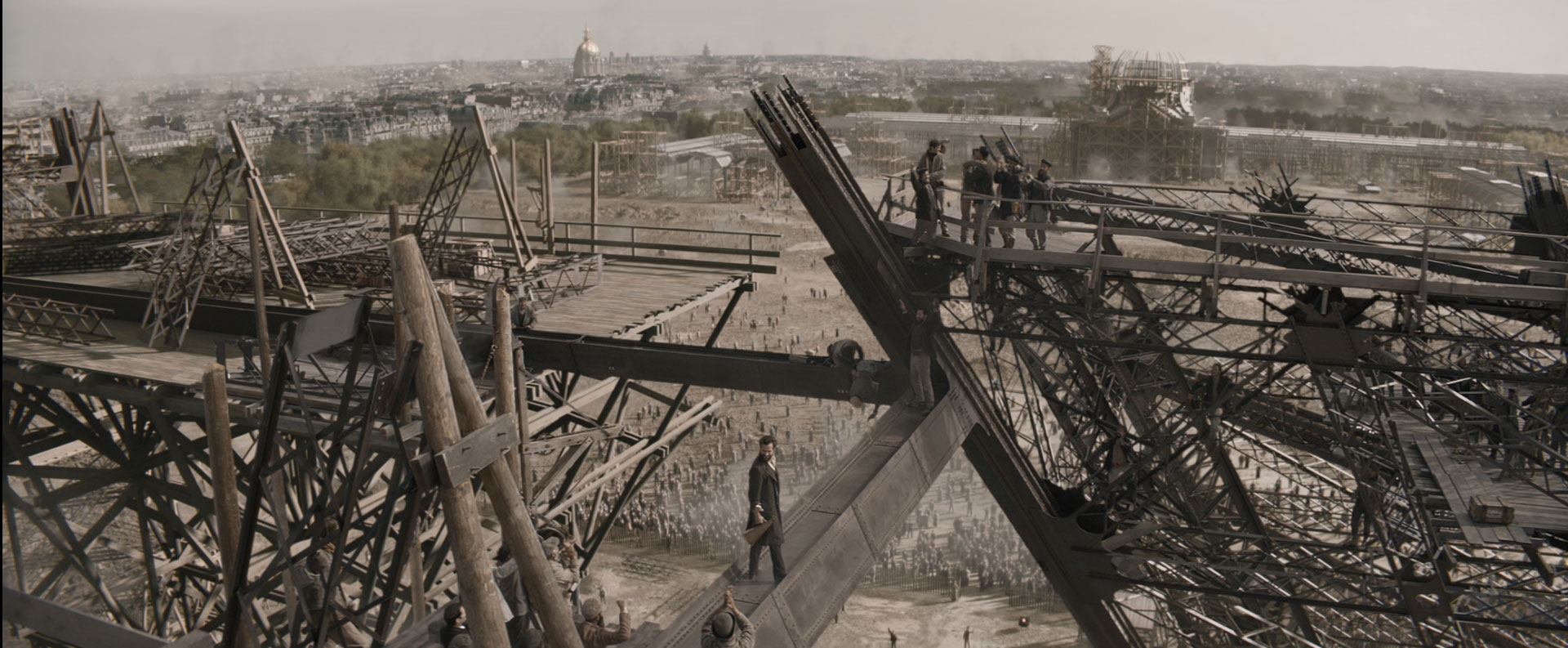In 2017, Olivier Cauwet explained the work of BUF on Blade Runner 2049. He then worked on several shows such as The Predator, Synchronic and Watchmen.
How did you get involved on this show?
In April 2018, the pre-production of Buf offered me the Eiffel project in preparation, produced by Vanessa van Zuylen and Pathé. I met the director, Martin Bourboulon, and his production team. This first contact was an opportunity for everyone to share their vision of the project and to discuss the various shooting options and the VFX.
How did you feel about bringing to life the origins of the creation of such an iconic monument as the Eiffel Tower?
Talking about the Eiffel Tower is never an easy task. And I’m not talking about its dimensions. It is one of the most famous monuments in the world and certainly the most visited. In France, I think that there is not a home without an image of the tower, that is to say a trinket, a print, a book, a bag, a cloth, etc … You do not spend a day without seeing its representation somewhere. It is a monument that shines, just by its silhouette, which places Paris on the world map. I have traveled a lot, and I can attest to the enthusiasm it causes and to what extent it is everywhere. So yes, when you have to create it and tell the story of its construction, you feel a certain positive pressure and above all extremely motivating.
People love the tower, but are not always aware of the ingenuity that goes into its construction. We always like to know the tricks, the secrets of magicians, behind the scenes of great events, the film tells it and brings another point of view, a little more epic and romantic of this great iron lady.
How was the collaboration with Director Martin Bourboulon?
Martin always talks about feelings, movements, sensations, emotions. He never communicates through technique. You have to listen, interpret, bounce back and propose. Martin gives everyone a lot of freedom and workspace, he lets thoughts and ideas come to him and bounces off them. During the preparation, we asked to storyboard the large VFX sequences, in order to work concretely between the departments, direction, set designer, DOP, around Martin’s vision.
That’s his first feature with big VFX sequences. How did you help him about that?
First of all, the main idea is not to give the feeling of complexity as soon as you speak VFX, so that it does not become exclusively technical. During Martin’s first visit to Buf premises, we took some time to go through and explain the different stages of creating a VFX shot, such as the ones we would have in Eiffel.
Secondly, Jonathan Delerue storyboarded the main sequences, which allowed me to explain the approach to filming and the VFX involvement for each kind of shot. For this project, I did not imagine shooting in a studio, on a green screen, for a realistic approach of the image, the light, the integration. It also gives the opportunity to Martin to project himself into the scenes. During the construction site sequences, shooting in the studio would never have given the notions of orientation, height, distances. This is what defines the tower, it has dimensions such that everything is gigantic. We needed distance, a horizon.
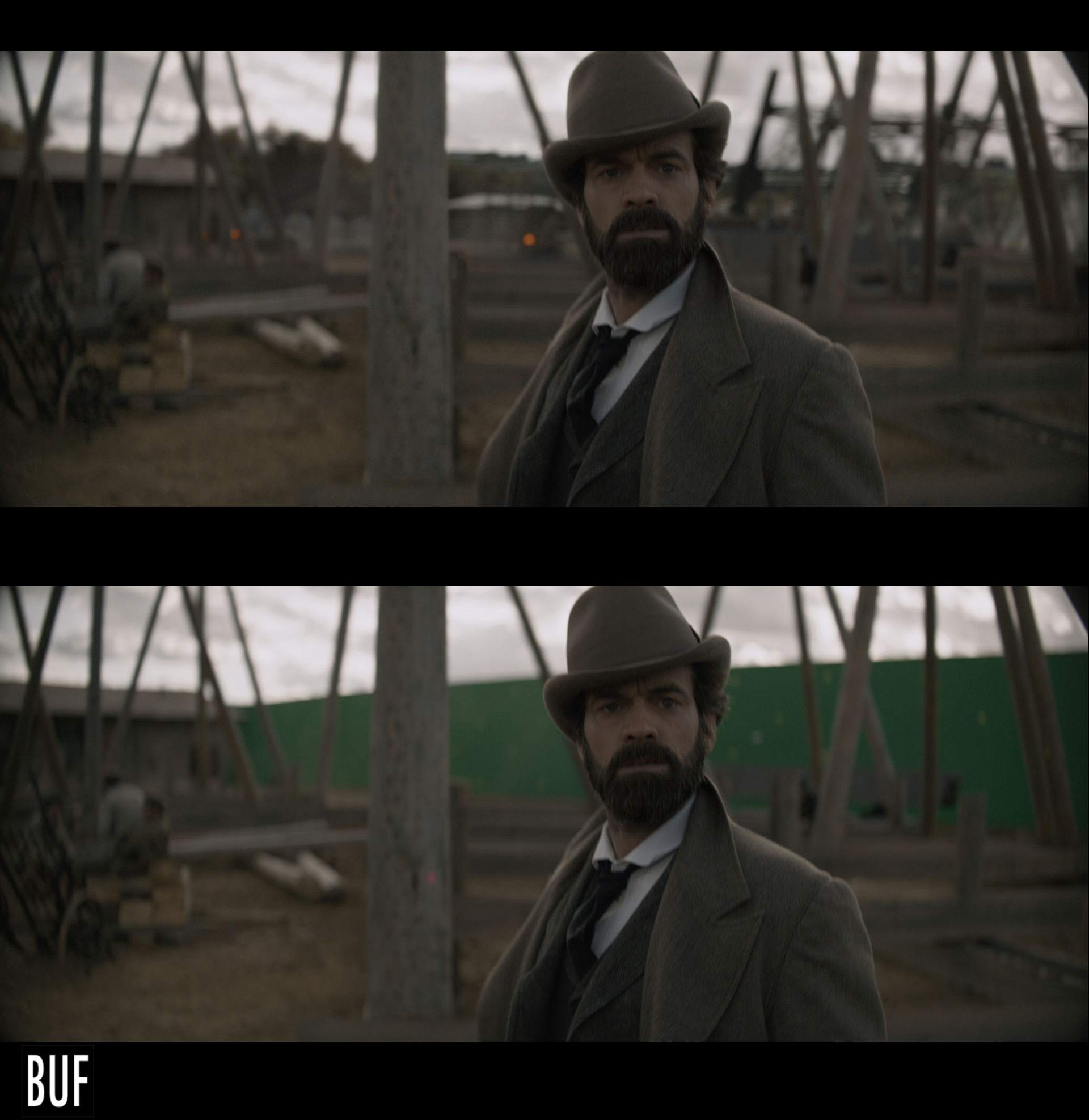
What was his approach and expectations about the visual effects?
From day one, Martin has expressed his desire to film the tower at human height. He wanted a constantly moving camera, on the shoulder, close to his actors. You have to live with them, evolve with Eiffel in the construction site, discover this immense tower under construction, while the audience is also looking up. In one word, to be “immersive”. We had the same point of view: the VFX had to help the story, to give depth to the sets, to reinforce the feeling of height, of vertigo, but never to take over. He didn’t want “effects” shots. With Matias Boucard, cinematographer, and Stéphane Taillasson, production designer, we shared the same vision. Work the foreground in practical and use VFX to extend it. We didn’t want full digital shots. It didn’t fit into our visual grammar of the Eiffel movie.
How did you organize the work with your VFX Producer?
Justine Paynat-Sautivet is VFX producer of the film “Eiffel”, at Buf. During the editing, Justine contacted Thierry Onillon, VFX producer at Mac Guff, in order to organize and share some sequences of the film that we had defined together. Justine managed the VFX budget, the planning, the production monitoring, the human resources, the communication with production and with Mac Guff.
My role was to ensure the realization of Martin’s vision as well as the quality and consistency of the work carried out on each VFX plan. I set up the production pipeline, the key for the organization and the production of shots by the team. I defined the technical choices, and ensured the artistic follow-up. I also made VFX shots. Every morning, Justine and I organized dailies with the team to review and talk about the work in progress with the artists. Everyone knew what to do when they left this meeting.
Once a week, we presented the shots in progress to Martin in our projection room.
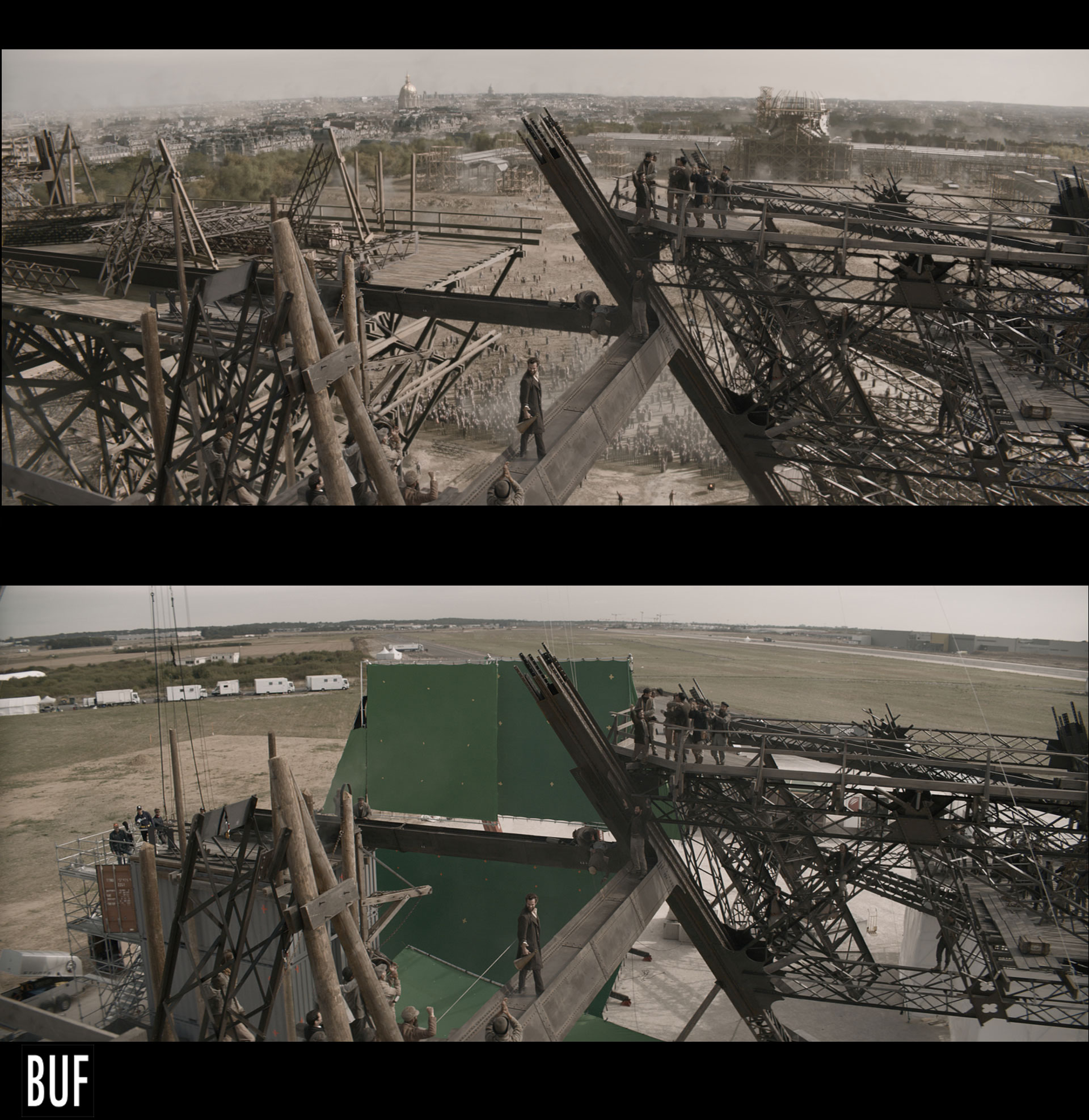
What was your approach to recreate this iconic monument?
The Eiffel Tower, built in 1889, is different in some ways from the one we know today. The first floor was different, the stairs were spiral, the elevators were not yet in use, and the third floor was also different. To reconstruct it in 3D, as faithfully as possible, I based myself on books, “I built the IRON tower” by Fabien Sabatès, and “The 300 meter tower” from the Taschen edition. The latter presents the sectional construction plans of the tower in 1889. It contains all the main blue prints and information about its architecture. So we simply followed it as a Meccano plan. Each piece of puddled iron has been redone in 3D and assembled according to the plans. Its architecture is mainly composed of repeated segments and a game of symmetry. We therefore managed its construction in 3D with scripts, the best technique. From then on, the tower was automatically updated at the slightest change in a component part.
What was the real size of the Eiffel Tower on the set?
For the film, a part of the base of the full-size tower was built by the team of Stéphane Taillasson, production designer, on the backlot of TSF in Brétigny. This foot of 11m high and 15m wide, was going to serve us as an open-air studio for all the sequences on the ground, like those at height.
It is a real project in itself. The foot had to accommodate actors and the team at all its levels while it is leaning. It was not possible to dig foundations, so the structure stands upright, thanks to concrete blocks. It took the validation of a design office for its realization.
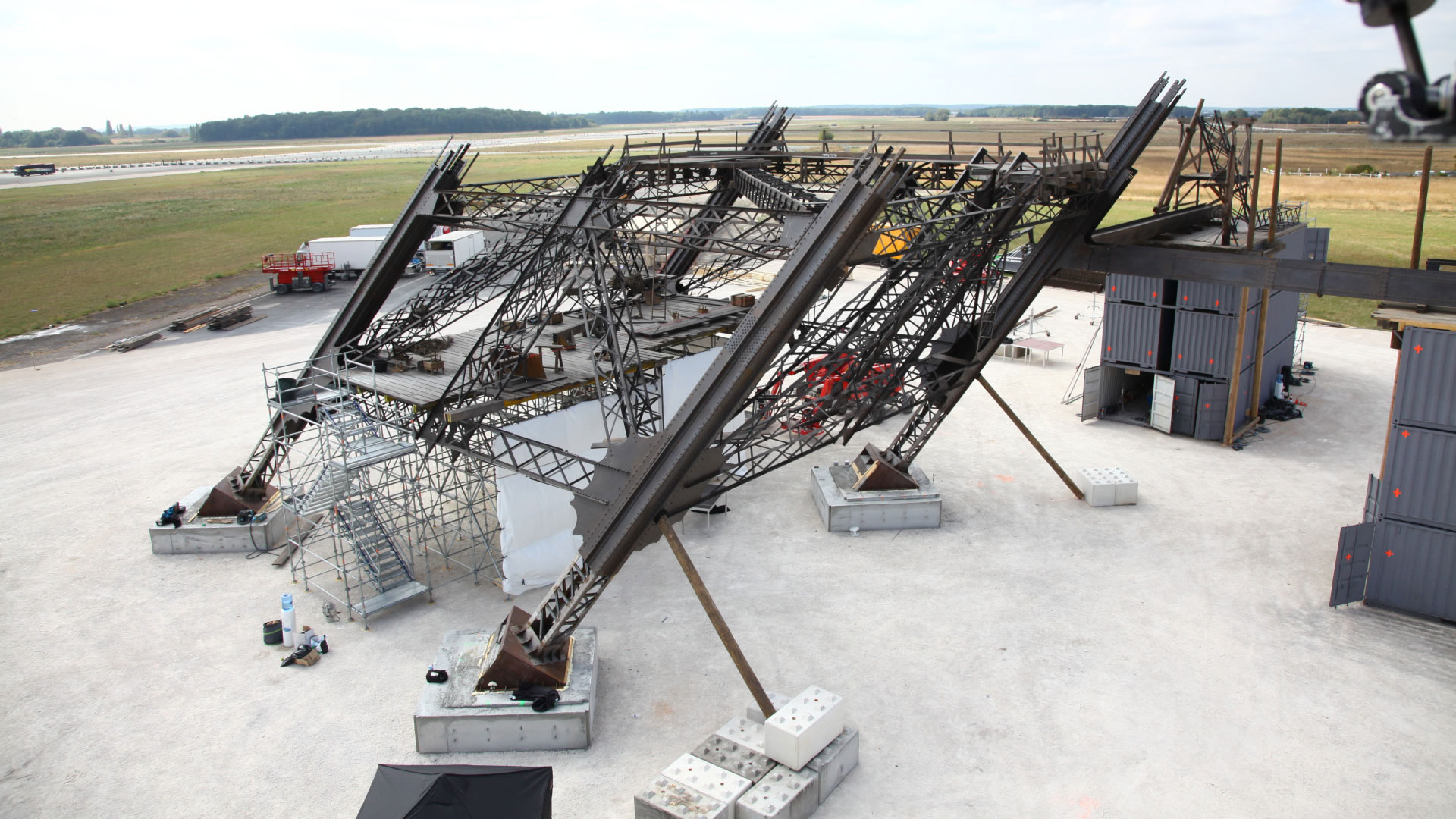
This foot allowed us to film the sequence of the junction of the beam, in which Romain Duris and the actors move on the structure at 8m high. Our job was to extend the tower under construction downwards, to recreate the construction site with the workers in 3D and the surrounding Paris seen from 40 m high.
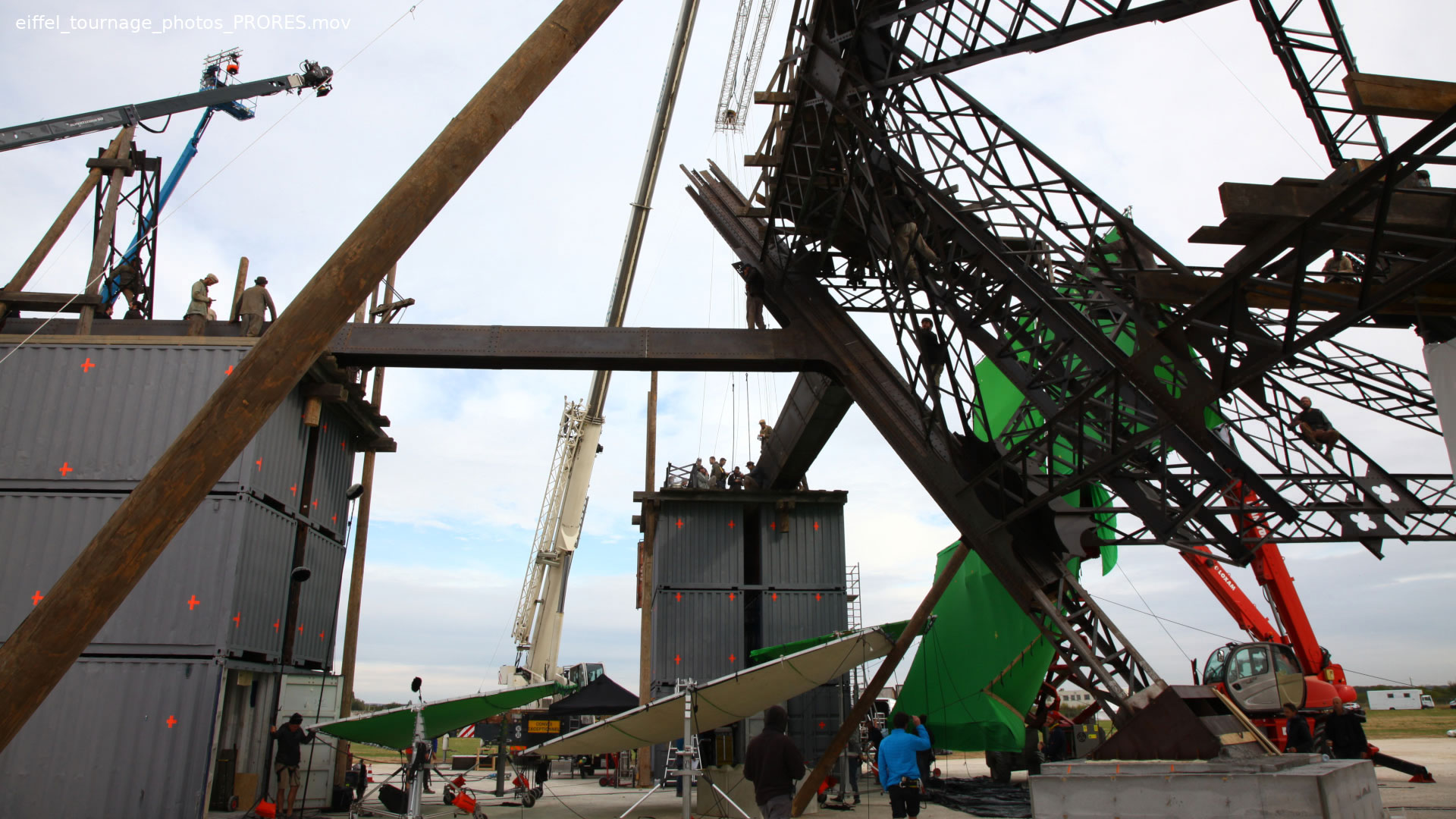
During Eiffel’s lunch with Claire, his daughter, we filmed this scene in the heart of the foot at a height of about 5 m. We have placed green backgrounds with nacelles, in order to recreate Paris and its construction site seen from 30 m high.
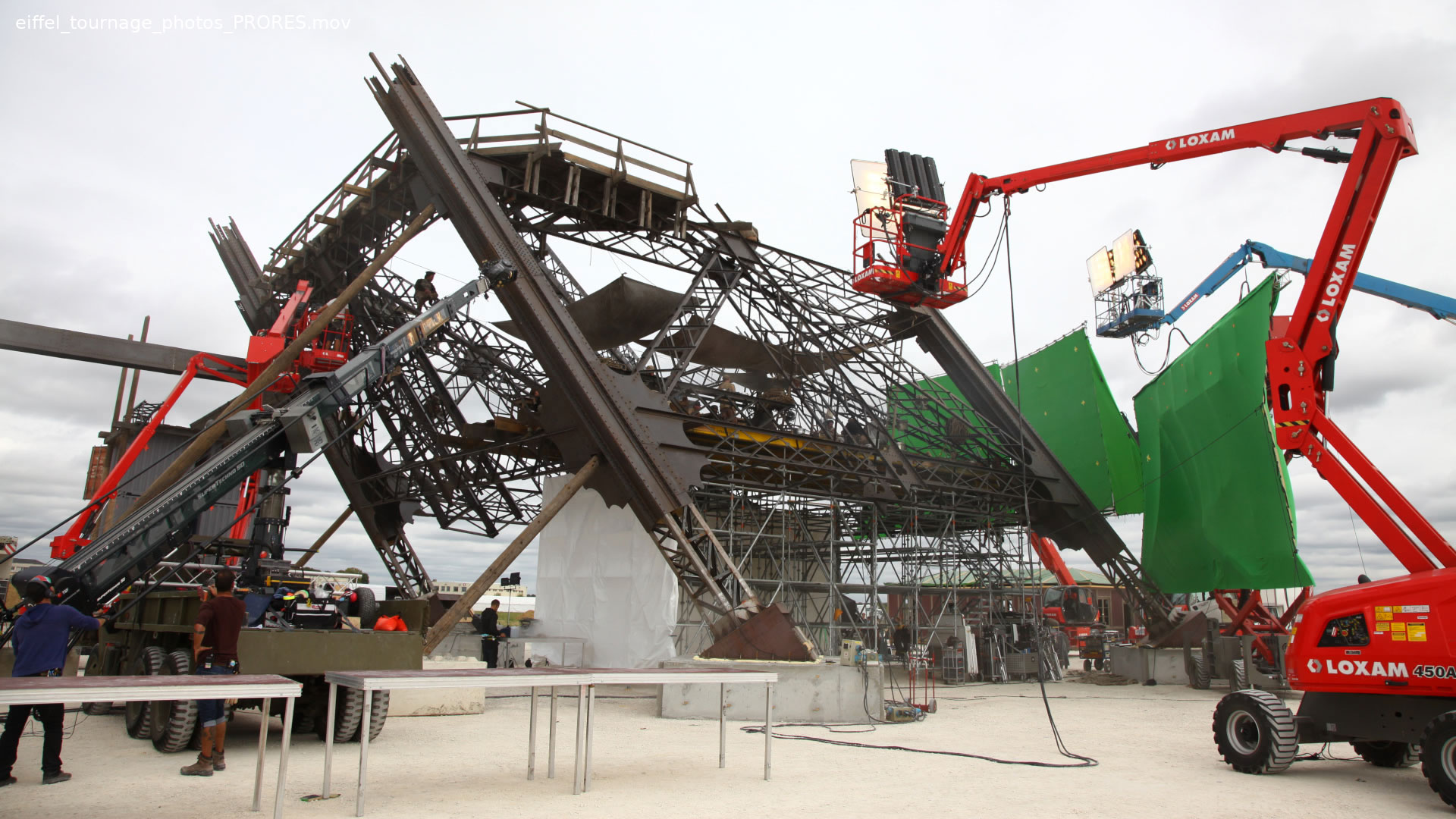
Finally, for the sequences on the ground, the production design team reproduced the bases of the masonry feet as well as the bases of the goats and wooden props supporting the foot of the tower. In addition to the foot, a whole site of approximately 80 m x 80 m was built in which Eiffel and his workers could evolve and tell the story of the construction. Despite these giant sets and as we are talking about the Eiffel Tower with its extraordinary dimensions, this barely represented a quarter of the actual construction site.
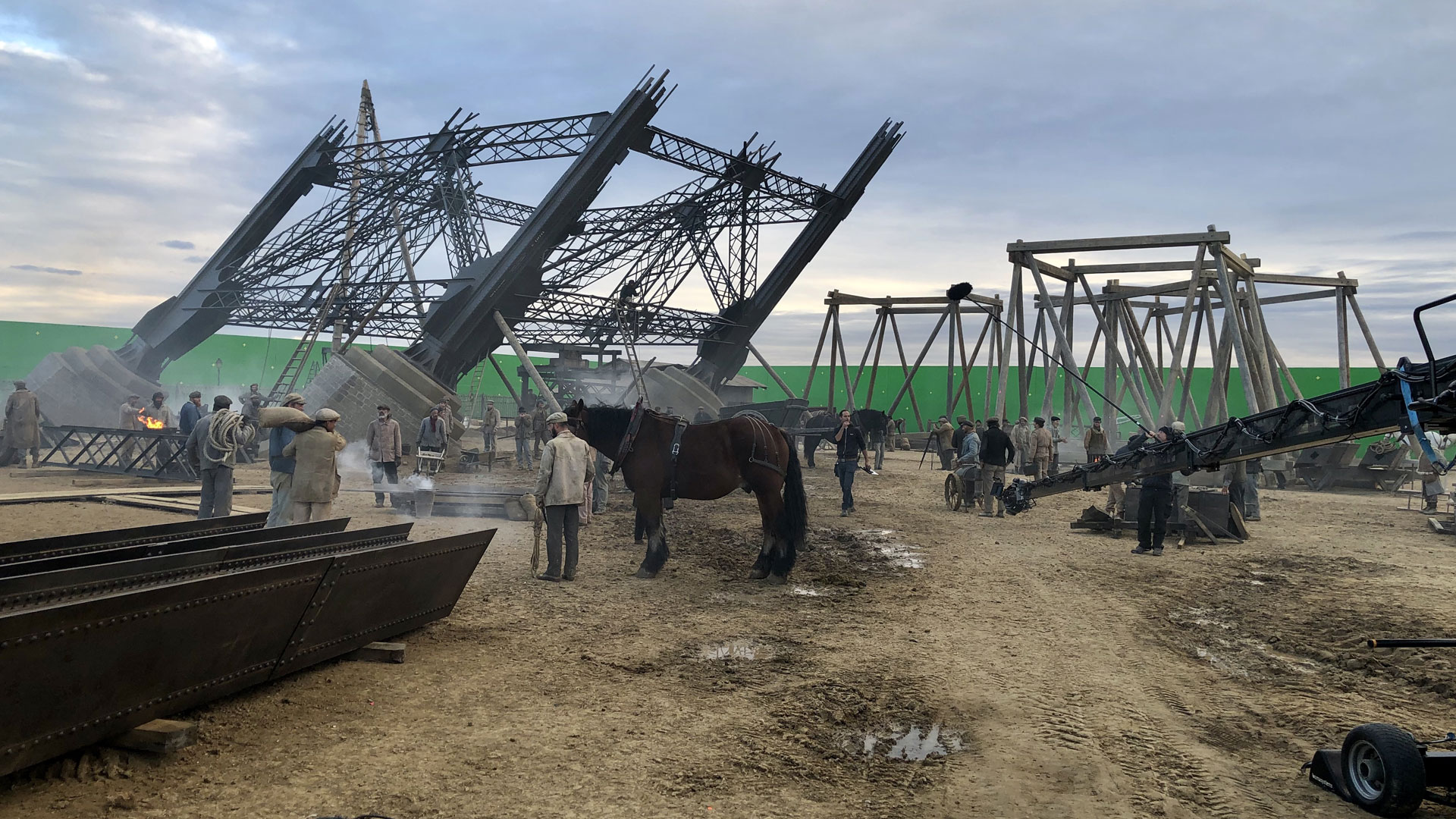
We therefore recreated in 3D the remaining 3 quarters with the other pillars of the tower, as well as its Parisian environment. In the series of non-standard figures, it was necessary to create a 140 m long green screen. It delimits the site, according to the turning axes and the sunpath. As we were working on the backlot of TSF, a former military airfield runways, we faced the problem of wind. The only solution was to paint in green 12 m long containers on two floors.
Can you explain in detail about the creation of the Eiffel Tower?
As I said, we created the tower according to the construction plans. We modeled and set up each part with our nodal programming tools, “Neuro”, based on the original tower blueprints. It was also necessary to create several stages of the construction of the tower. Once these have been established, according to the script and our discussions with Stéphane Taillasson and Martin Bourboulon, we have created one asset per sequence. In addition to the tower, the entire construction site is evolving. The scaffolding and the wooden goats, the structures on the ground, are more or less present and more or less high according to the construction schedule. It was necessary to pay particular attention to all these details and to the periods of the sequences. I had created a document referencing the work in progress of the construction site for each sequence of the film.
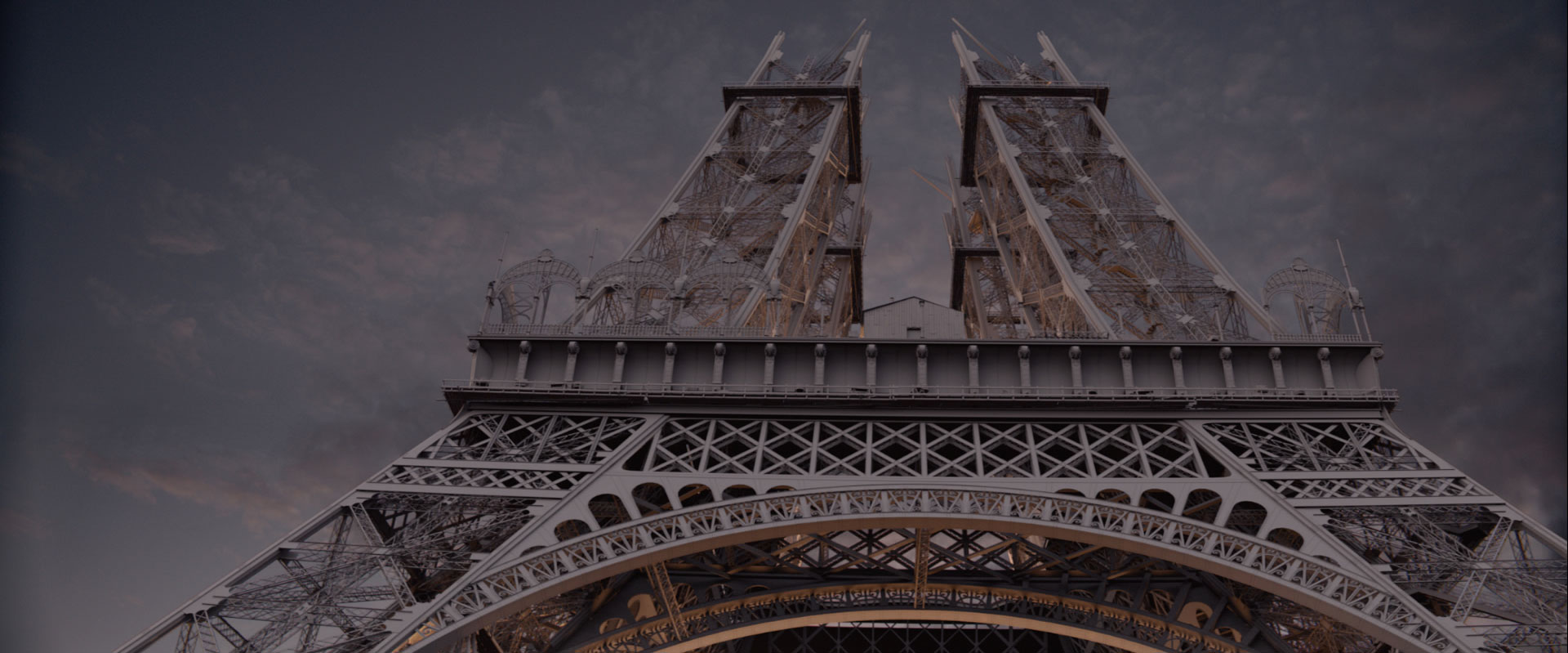
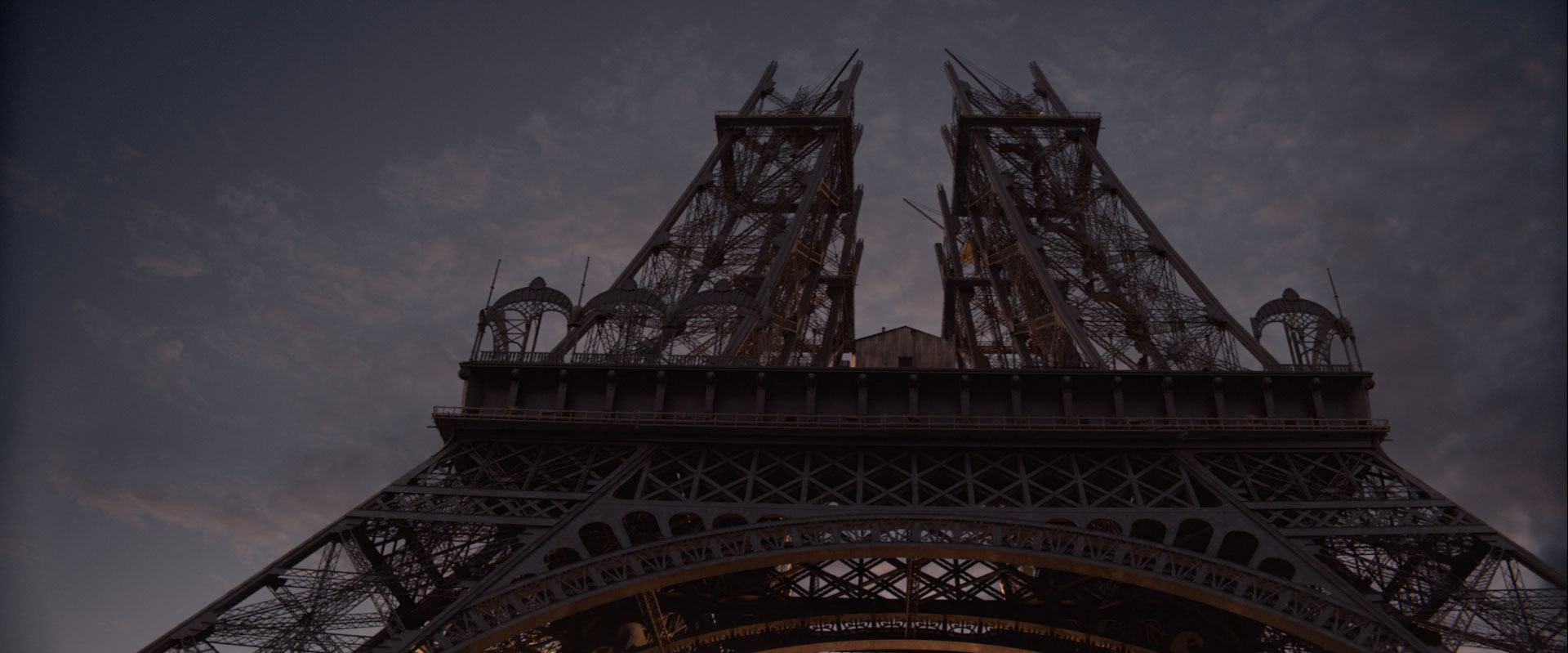
How did you handle the various lighting conditions of the Eiffel Tower?
From the beginning, we were aware that we were weather dependent. But the weather conditions were a force to tell the story of the site over its entire period. Visually, it is much more interesting and richer. The light and the atmospheres on the digital sets are adapted to those of the shots in which they are integrated. The audience does not have the feeling of always seeing the same thing. During filming, we captured HDR for each shot in order to be as accurate as possible during integration.
Can you explain in detail about the recreation of the Paris of the 19th Century?
There are two Paris in our approach:
The first is everything that surrounds the construction site of the tower and the Champ de Mars up to the Ecole Militaire. It is a 3D Paris, modeled and set up according to the maps of the 1889 Universal Exhibition. We started by reconstructing “le Palais du Trocadéro”, since destroyed and replaced by “ le Palais de Chaillot ”. Many spectators will discover this building thanks to the film. We have modeled and textured it from historical photos, from different points of view, including that of the first floor of the tower. All the buildings surrounding the site and the “Champ de Mars” have been modeled and textured. Likewise, during the construction of the Eiffel Tower, the site of the Universal Exhibition is being built in parallel. We therefore recreated the construction sites of “le Palais des Industries” hiding the “Ecole Militaire”, of the “Palais des Beaux Arts et Arts Libéraux” seen from the tower and which were finished during the inaugural sequence. The 19th century industry ran with fossil fuel, so there were huge brick chimneys spewing their smoke over Paris. This smoky atmosphere, assumed in the look of the film, was justified by these chimneys in the wide shots.
The second Paris, far in the background, is a matte painting. Francois Hamel, production’s manager, arranged access to the Eiffel Tower for 12 hours. We took pictures of Paris, throughout the day, from each floor of the tower. In addition to work, being on the top floor, alone, for the sunrise, as a Parisian, it’s magic. These photos allowed us to carry out the background matte paintings, we cleaned them up to remove all the anachronisms, added green spaces, cleared up the streets made of earth, and we took into account the history of the monuments. For example, “le Petit Palais” and “le Grand Palais” were removed, as they will be built later, for the universal exhibition of 1900.
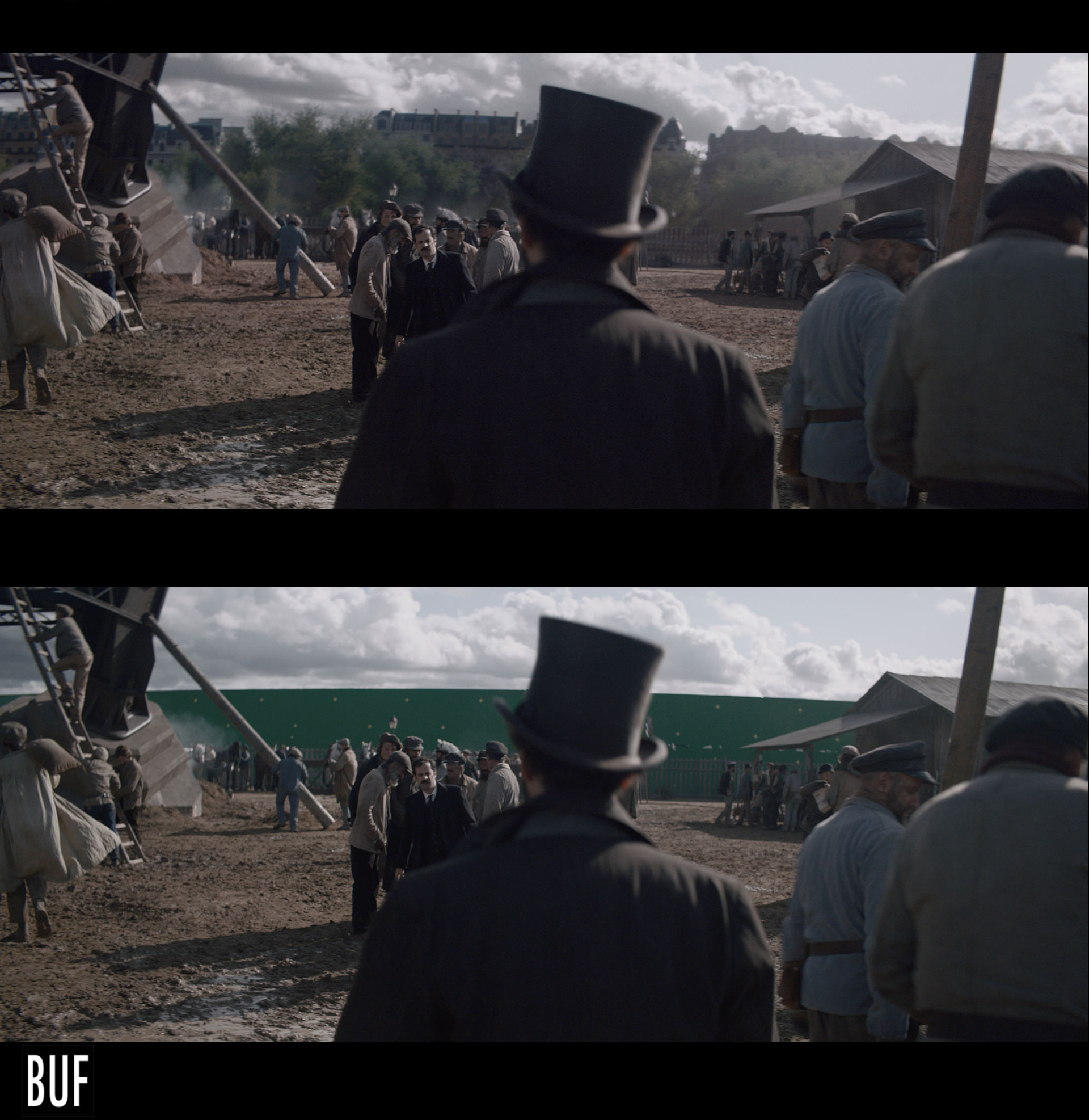
What was your main source of references and influences to recreate the Tower and Paris?
As I specified, my references were the books, the paintings and the documents of the BNF. The paintings give us an interpretation of the atmosphere, the colors, the atmospheres of the time. We make cinema, as Martin liked to say: “we don’t make a period film for historians”. So you have to make it visually interesting, reality can be boring sometimes …
How did you populate and animate the crowds?
During the shooting, we took pictures of some extras wearing the costumes, created by Thierry Delettre and his team. We modeled and animated them with our in-house crowd system, to expand the population of the streets of Paris, the inauguration crowd, and the construction site workers. We also filmed the extras in action in front a green screen, to easily add people to unforeseen shots.
How did you choose the various vendors?
In order for production to benefit from the new technology aids, we had to share the shots with another visual effects company, up to 20% of the VFX budget. Naturally, we turned to Mac Guff for their great work and their mastery of visual effects. There was the de-aging of the character of Eiffel during flashbacks, the construction of the Bordeaux bridge to be created, as well as a set of plans: exterior sets to be cleaned, Eiffel’s drawings to be enhanced, and various cleans.
CGEV was involved at the end of post-production and worked on cleaning 131 shots. But we did not collaborate together.
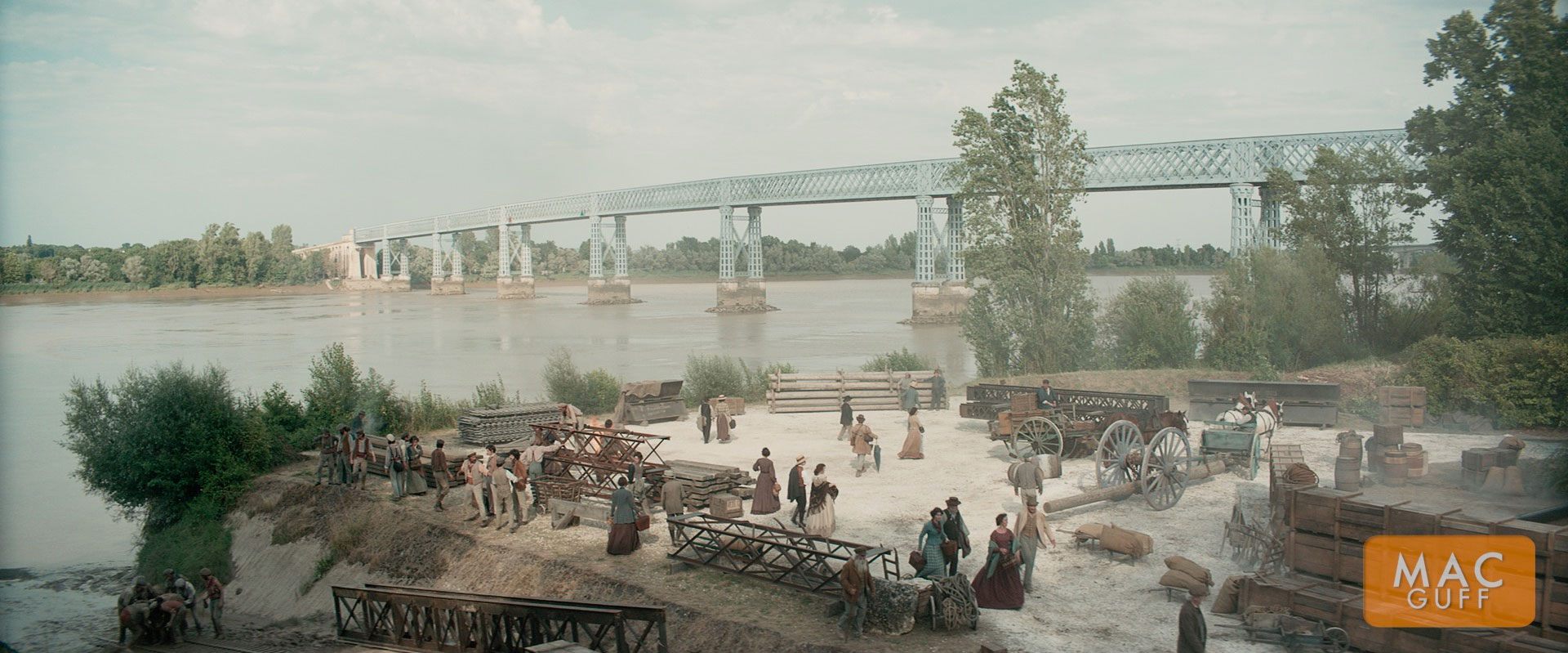
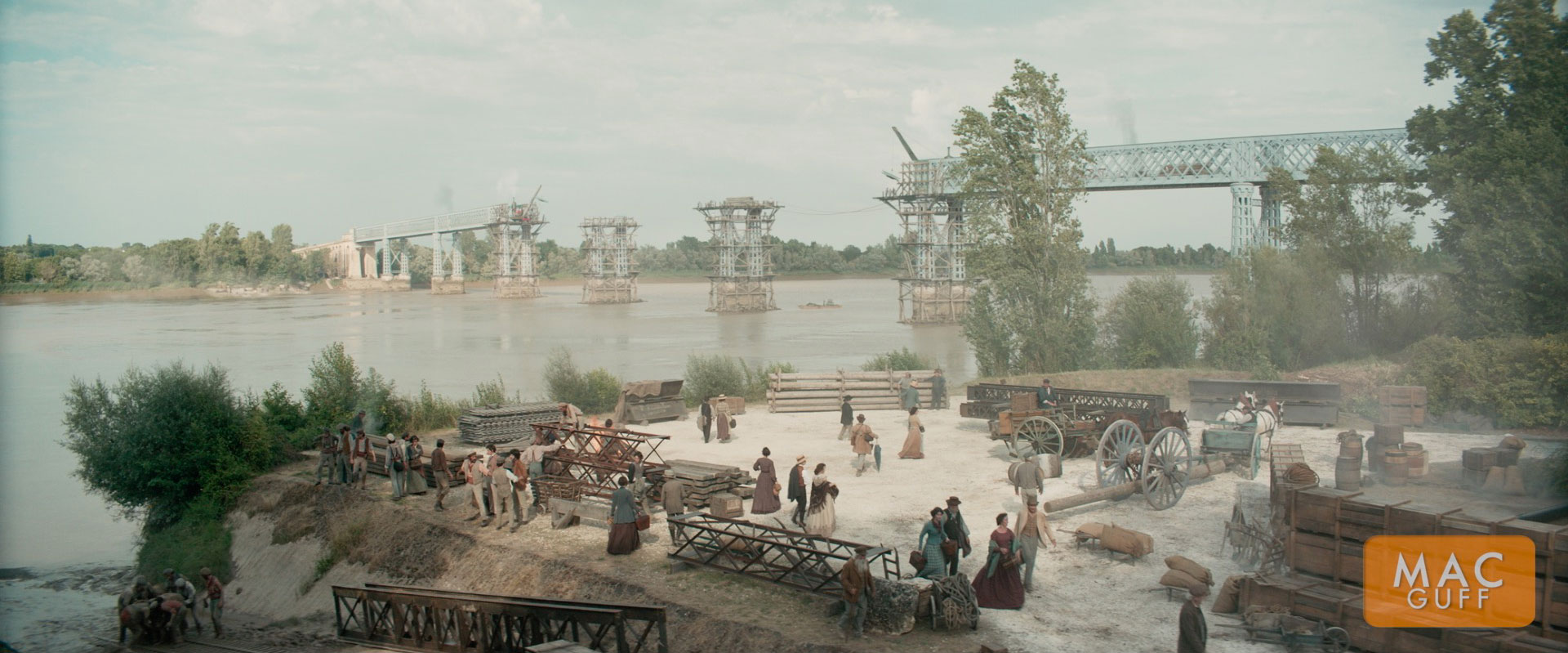
How was the collaboration with their VFX Supervisors?
Mac Guff’s team is supervised by Bruno Sommier. We were in regular contact to follow up the work in progress, and prepare the weekly presentations to Martin. Bruno and his team have done a wonderful job. Their work on Eiffel de-aging is transparent. The whole sequence of the Bordeaux Bridge construction site is magnificent. They carried out 111 VFX shots. Our association has been very smooth.
Is there something specific that gives you some really short nights?
The schedule, like many supervisors.
What is your favorite shot or sequence?
I love the shot of the painter hanging from the tower. It’s an improvised shot on set, but once the VFX made, it is visually impressive on the big screen. And the sequence of the junction of the main beam is only composed of big VFX shots.
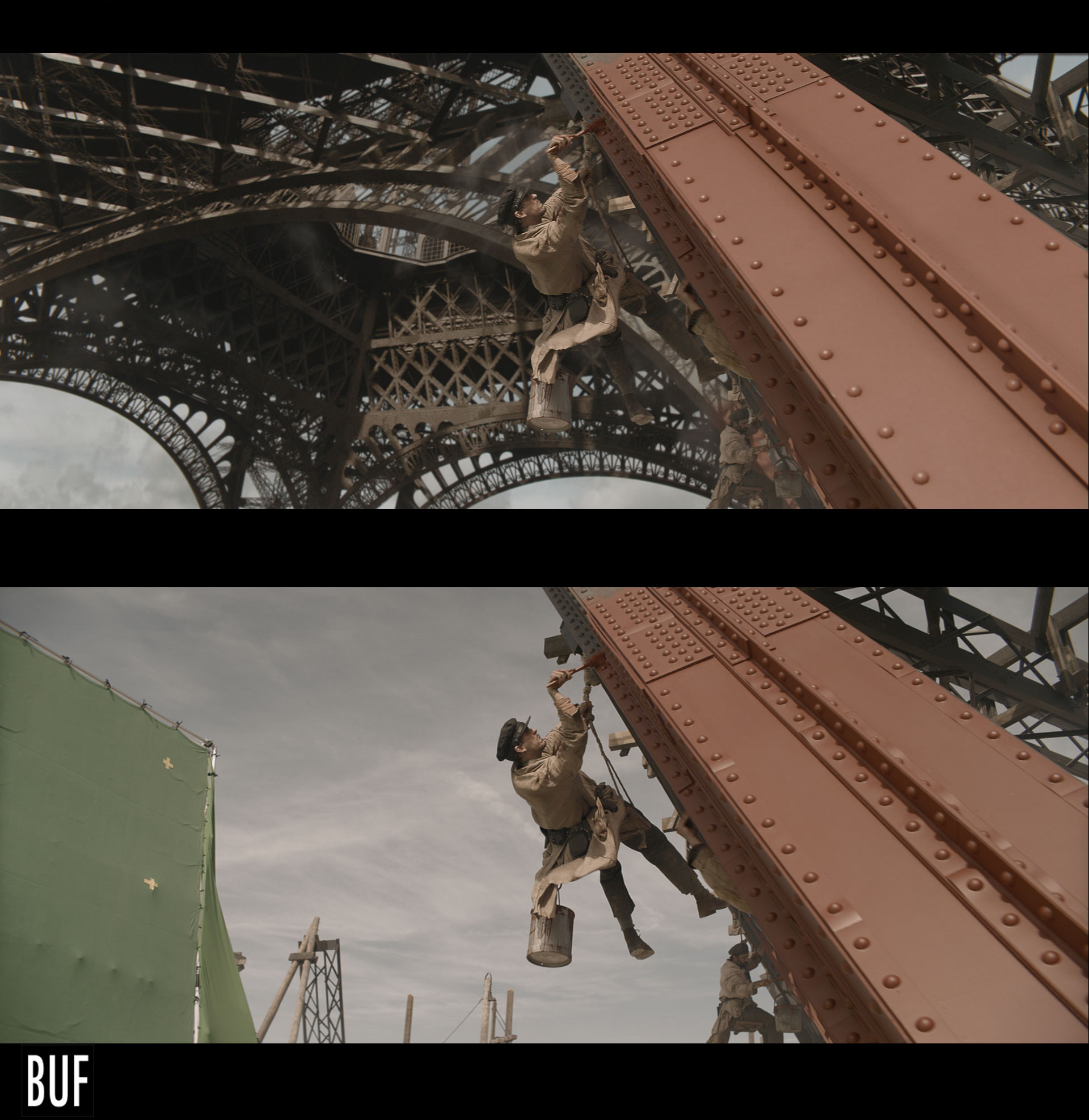
What is your best memory on this show?
The visual effect artists team I worked with. Truly. I told them. It was a pleasure working alongside them every day. To build this tower, to do these VFX shots with them. I have seen young artists get off with a good start, artists confirm their talents and future supervisors. As with many of my projects, telling myself that I was involved in their progress is my best memory.
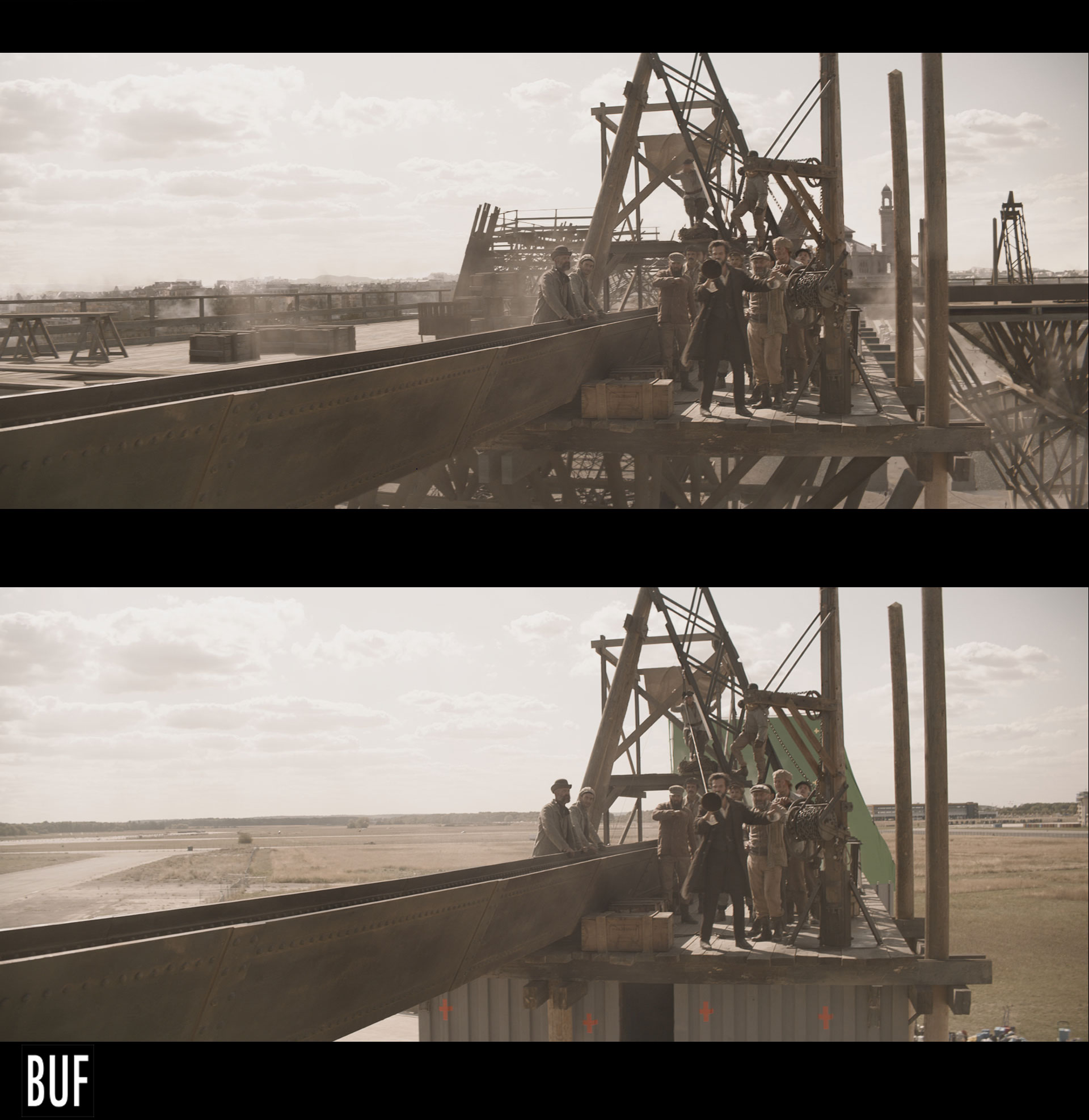
How long have you worked on this show?
I worked for 2 years on Eiffel. From preparation in 2019, to filming, until the final delivery of the VFX in early February 2021. The second part of the filming was delayed by confinement. Then we had to manage the Covid periods by organizing ourselves with health measures and teleworking.
What’s the VFX shots count?
The Eiffel film contains 560 VFX shots made by Buf, Mac Guff and the CGEV.
This represents approximately 61 minutes of the film.
If it’s not a secret, are you already busy on a new show?
I am currently supervising the VFX of the next two films of Martin Bourboulon. Les Trois Mousquetaires: D’Artagnan and Les Trois Mousquetaires: Milady produced by Chapter 2 and Pathé which we are filming at the same time.
A big thanks for your time.
WANT TO KNOW MORE?
BUF: Dedicated page about Eiffel on BUF website.
© Vincent Frei – The Art of VFX – 2021


